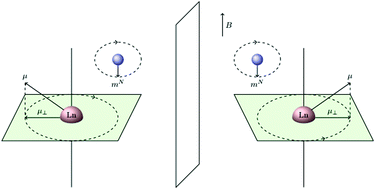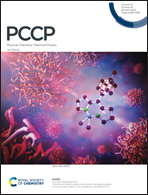Effect of magnetic anisotropy on direct chiral discrimination in paramagnetic NMR spectroscopy†
Abstract
We present and analyse a complete analytic expression for the generalized shielding polarizability third-rank tensor Φαβγ, whose isotropic average, the pseudoscalar ![[capital Phi, Greek, macron]](https://www.rsc.org/images/entities/i_char_e0c1.gif) , is proportional to a chiral macroscopic electric polarization P measurable in a pulsed nuclear magnetic resonance (NMR) experiment probing molecules with an arbitrarily degenerate ground state, in solution. We have recently predicted that
, is proportional to a chiral macroscopic electric polarization P measurable in a pulsed nuclear magnetic resonance (NMR) experiment probing molecules with an arbitrarily degenerate ground state, in solution. We have recently predicted that ![[capital Phi, Greek, macron]](https://www.rsc.org/images/entities/i_char_e0c1.gif) can be measurable at room temperature in chiral paramagnetic molecules, and identified strong magnetic anistropy (as featured e.g. in lanthanide complexes) as a crucial molecular property to achieve room temperature chiral discrimination using NMR spectroscopy. As previously proposed, the components of Φαβγ are obtained as analytical third derivatives of the electronic free energy. Here we present the explicit calculation of these derivatives, which provide working expressions for the explicit accurate ab initio calculation of Φαβγ. We apply our theory by performing ab initio multiconfigurational calculations of all contributions to Φαβγ, for a set of ten DyIII complexes, characterized by a strongly axial ground Kramers doublet, but also by thermally accessible excited Kramers doublets at room temperature. The results show that the thermally populated excited state contributions, while generally reducing the value of
can be measurable at room temperature in chiral paramagnetic molecules, and identified strong magnetic anistropy (as featured e.g. in lanthanide complexes) as a crucial molecular property to achieve room temperature chiral discrimination using NMR spectroscopy. As previously proposed, the components of Φαβγ are obtained as analytical third derivatives of the electronic free energy. Here we present the explicit calculation of these derivatives, which provide working expressions for the explicit accurate ab initio calculation of Φαβγ. We apply our theory by performing ab initio multiconfigurational calculations of all contributions to Φαβγ, for a set of ten DyIII complexes, characterized by a strongly axial ground Kramers doublet, but also by thermally accessible excited Kramers doublets at room temperature. The results show that the thermally populated excited state contributions, while generally reducing the value of ![[capital Phi, Greek, macron]](https://www.rsc.org/images/entities/i_char_e0c1.gif) calculated on the assumption of a thermally isolated ground state, still confirm the room temperature detectability of this property for all ten studied complexes. Trends on the relative sign of dominant contributions are then discussed on the basis of a crystal field model electrostatic potential splitting a ground spin–orbit multiplet, which provides an insight into the properties of the generalized shielding polarizability tensor for open shell species.
calculated on the assumption of a thermally isolated ground state, still confirm the room temperature detectability of this property for all ten studied complexes. Trends on the relative sign of dominant contributions are then discussed on the basis of a crystal field model electrostatic potential splitting a ground spin–orbit multiplet, which provides an insight into the properties of the generalized shielding polarizability tensor for open shell species.

- This article is part of the themed collection: 2020 PCCP HOT Articles


 Please wait while we load your content...
Please wait while we load your content...